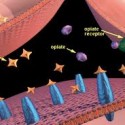New Mexico turns a corner on drunk driving
Kenny Martinez demonstrates blowing into his ignition interlock to start his truck in Santa Fe, N.M.
The state once led the nation in alcohol-related crash deaths. But tough measures, including an ignition-interlock requirement for all convicted drunk drivers, are paying off.
For the last seven years, Horace, a four-time convicted drunk driver, has lived with an electronic probation officer in the front seat of his red sedan. The device, an “ignition interlock,” acts as a breath-alcohol analyzer and requires him to prove he’s sober before the engine will start.
New Mexico, which led the nation in alcohol-related crash rates for years, in 2005 became the first state to require the interlock for every convicted drunk driver. The interlock legislation has been the centerpiece of the state’s sweeping anti-drunk-driving efforts, which include more sobriety checkpoints, tougher mandatory sentencing laws for driving while intoxicated, and the creation of the nation’s first DWI czar.
The initiatives have paid off.
New Mexico, home to high rates of alcohol abuse and miles and miles of open road, is now ranked 25th in alcohol-related fatal crash rates and is expected to place lower when the latest rankings are compiled later this year. From 2004 to 2008, the number of DWI fatalities here dropped 35%, from 219 to 143.
“We want all 50 states to do what New Mexico has done,” said Chuck Hurley, chief executive of Mothers Against Drunk Driving. MADD has mounted an aggressive campaign to persuade the rest of the country to require interlocks.
If each of the more than 1.4 million Americans convicted each year of drunk driving were forced to install one, Hurley said, 4,000 lives would be saved annually.
In California, the Assembly recently approved a bill that would fund a five-year pilot program to require interlocks for convicted drunk drivers in Los Angeles, Alameda and Sacramento counties.
Assembly Bill 91, sponsored by Mike Feuer (D-Los Angeles), will be heard by the Senate Public Safety Committee today.
Eleven states have phased in mandatory interlock laws since New Mexico did so, including six this year.
But as more states turn to interlocks because of the good they can do, there are daily reminders of what they can’t.
In Santa Fe recently, a man who police say was drunk and driving in the wrong lane plowed into a car carrying five teenagers, killing four and severely injuring the fifth.
The driver, 27-year-old Scott Owens, had been convicted of DWI and street racing in 2001, four years before the first-offender interlock law was passed.
Even if Owens had been ordered to get an interlock in 2001, he probably wouldn’t have had one now. In New Mexico, first-time drunk driving offenders must drive with an interlock for one year (second-time offenders must have it for two years, third-time offenders for three years, and fourth-time offenders for the rest of their lives).
There are other limitations. According to DWI czar Rachel O’Connor, 70% of drunk drivers who kill and injure people in accidents have never been convicted of drunk driving, and thus have never had an interlock.
“The interlock is a saving grace, but the problem has not gone away,” said state Sen. Phil Griego. New Mexico has a long track record of drunk driving deaths. At the peak of the state’s DWI crash rate, in 1990, more than 60% of all traffic deaths involved alcohol.
The statewide backlash against DWI took off in 1992, when a drunk driver going the wrong way on Interstate 40 crashed into a car carrying a family on Christmas Eve, killing a mother and her three young girls.
The ensuing outrage spurred lawmakers to lower the blood-alcohol level (from 0.1 to 0.08), shutter the state’s drive-through liquor windows, and mandate jail time for repeat drunk drivers.
Some progress was made, but soon DWI crash rates started rising again.
The problem, O’Connor said, is partly cultural. “New Mexico has typically been a heavy-drinking state,” she said. And because New Mexico is so big and so rural, people drive a lot. “You can really get out and gun it,” she said.
Kenny Martinez, 43, agrees that alcohol is a part of New Mexican culture. Martinez was first convicted of drunk driving in 1992 and racked up four more convictions over 15 years.
“When someone’s born, we drink. When someone dies, we drink,” he said. “We drink at baptismals, at birthdays. Oh, work’s off, let’s drink!”
Martinez eventually served prison time for his offenses. Now an anti-DWI activist who says he has been sober for two years, he thinks the state could cut down on drunk driving by doling out stiffer punishments and opening more halfway houses and rehab centers.
Another activist, Dick Roth, said the best solution would be “a car that drunks can’t drive.”
Carmakers are considering such a vehicle. In 2008 the Automotive Coalition for Traffic Safety, a trade group, and the National Highway Traffic Safety Administration launched a five-year, $10-million research program to develop built-in devices that would sense alcohol on a driver. In the meantime, said Roth, the interlock is the best thing.
Invented in the 1970s, the interlock has been used in some form in most states, including California, since the 1980s. Although it has been found to lower the recidivism rate of drunk drivers considerably, judges typically have required it for only the most extreme repeat offenders.
When the bill to mandate the installation of interlocks for all convicted drunk drivers came before the New Mexico Legislature in 2005, Sen. Griego rose and praised the device.
Griego said he had been a drunk driver for years — often daily. After he was convicted of his second DWI in 2001, a judge ordered him to install the device on his truck. The experience was embarrassing, he told his colleagues, but it kept him honest.
Today, there are about 9,000 interlocks in New Mexico.
Horace, who asked that his full name not be used so his boss wouldn’t know of his convictions, said the interlock has been, more than anything, an inconvenience. He has learned, for example, that he must limit his drinking to six beers before midnight, lest the interlock pick up on any lingering alcohol on his breath when he tries to go to work in the morning.
“It can tell if you’ve had an all-nighter,” he said. “But it’s a good thing because now it controls me.”
source: Los Angeles Times


